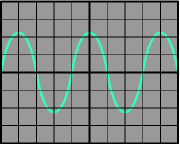An oscilloscope is a test instrument which allows you to look at the 'shape' of electrical signals by displaying a graph of voltage against time on its screen. It is like a voltmeter with the valuable extra function of showing how the voltage varies with time. A graticule with a 1cm grid enables you to take measurements of voltage and time from the screen.
The graph, usually called the trace, is drawn by a beam of electrons striking the phosphor coating of the screen making it emit light, usually green or blue. This is similar to the way a television picture is produced.
Oscilloscopes contain a vacuum tube with a cathode(negative electrode) at one end to emit electrons and ananode (positive electrode) to accelerate them so they move rapidly down the tube to the screen. This arrangement is called an electron gun. The tube also contains electrodes to deflect the electron beam up/down and left/right.
The electrons are called cathode rays because they are emitted by the cathode and this gives the oscilloscope its full name of cathode ray oscilloscope or CRO.
A dual trace oscilloscope can display two traces on the screen, allowing you to easily compare the input and output of an amplifier for example. It is well worth paying the modest extra cost to have this facility.
Precautions
- An oscilloscope should be handled gently to protect its fragile (and expensive) vacuum tube.
- Oscilloscopes use high voltages to create the electron beam and these remain for some time after switching off - for your own safety do not attempt to examine the inside of an oscilloscope!
Setting up an oscilloscope
Oscilloscopes are complex instruments with many controls and they require some care to set up and use successfully. It is quite easy to 'lose' the trace off the screen if controls are set wrongly!There is some variation in the arrangement and labelling of the many controls so the following instuctions may need to be adapted for your instrument.
- Switch on the oscilloscope to warm up (it takes a minute or two).
- Do not connect the input lead at this stage.
- Set the AC/GND/DC switch (by the Y INPUT) to DC.
- Set the SWP/X-Y switch to SWP (sweep).
- Set Trigger Level to AUTO.
- Set Trigger Source to INT (internal, the y input).
- Set the Y AMPLIFIER to 5V/cm (a moderate value).
- Set the TIMEBASE to 10ms/cm (a moderate speed).
- Turn the timebase VARIABLE control to 1 or CAL.
- Adjust Y SHIFT (up/down) and X SHIFT (left/right) to give a trace across the middle of the screen, like the picture.
- Adjust INTENSITY (brightness) and FOCUS to give a bright, sharp trace.
- The oscilloscope is now ready to use!
Connecting the input lead is described in the next section.

This is what you should see
after setting up, when there
is no input signal connected
Connecting an oscilloscope

Construction of a co-axial lead

Oscilloscope lead and probes kit
Photograph © Rapid Electronics
The Y INPUT lead to an oscilloscope should be a co-axial lead and the diagram shows its construction. The central wire carries the signal and the screen is connected to earth (0V) to shield the signal from electrical interference (usually called noise).
Most oscilloscopes have a BNC socket for the y input and the lead is connected with a push and twist action, to disconnect you need to twist and pull. Oscilloscopes used in schools may have red and black 4mm sockets so that ordinary, unscreened, 4mm plug leads can be used if necessary.
Professionals use a specially designed lead and probes kit for best results with high frequency signals and when testing high resistance circuits, but this is not essential for simpler work at audio frequencies (up to 20kHz).
An oscilloscope is connected like a voltmeter but you must be aware that the screen (black) connection of the input lead is connected to mains earth at the oscilloscope! This means it must be connected to earth or 0V on the circuit being tested.

The trace of an AC signal
with the oscilloscope
controls correctly set
Obtaining a clear and stable trace
Once you have connected the oscilloscope to the circuit you wish to test you will need to adjust the controls to obtain a clear and stable trace on the screen:- The Y AMPLIFIER (VOLTS/CM) control determines the height of the trace. Choose a setting so the trace occupies at least half the screen height, but does not disappear off the screen.
- The TIMEBASE (TIME/CM) control determines the rate at which the dot sweeps across the screen. Choose a setting so the trace shows at least one cycle of the signal across the screen.
Note that a steady DC input signal gives a horizontal line trace for which the timebase setting is not critical. - The TRIGGER control is usually best left set to AUTO.
If you are using an oscilloscope for the first time it is best to start with an easy signal such as the output from an AC power pack set to about 4V.
